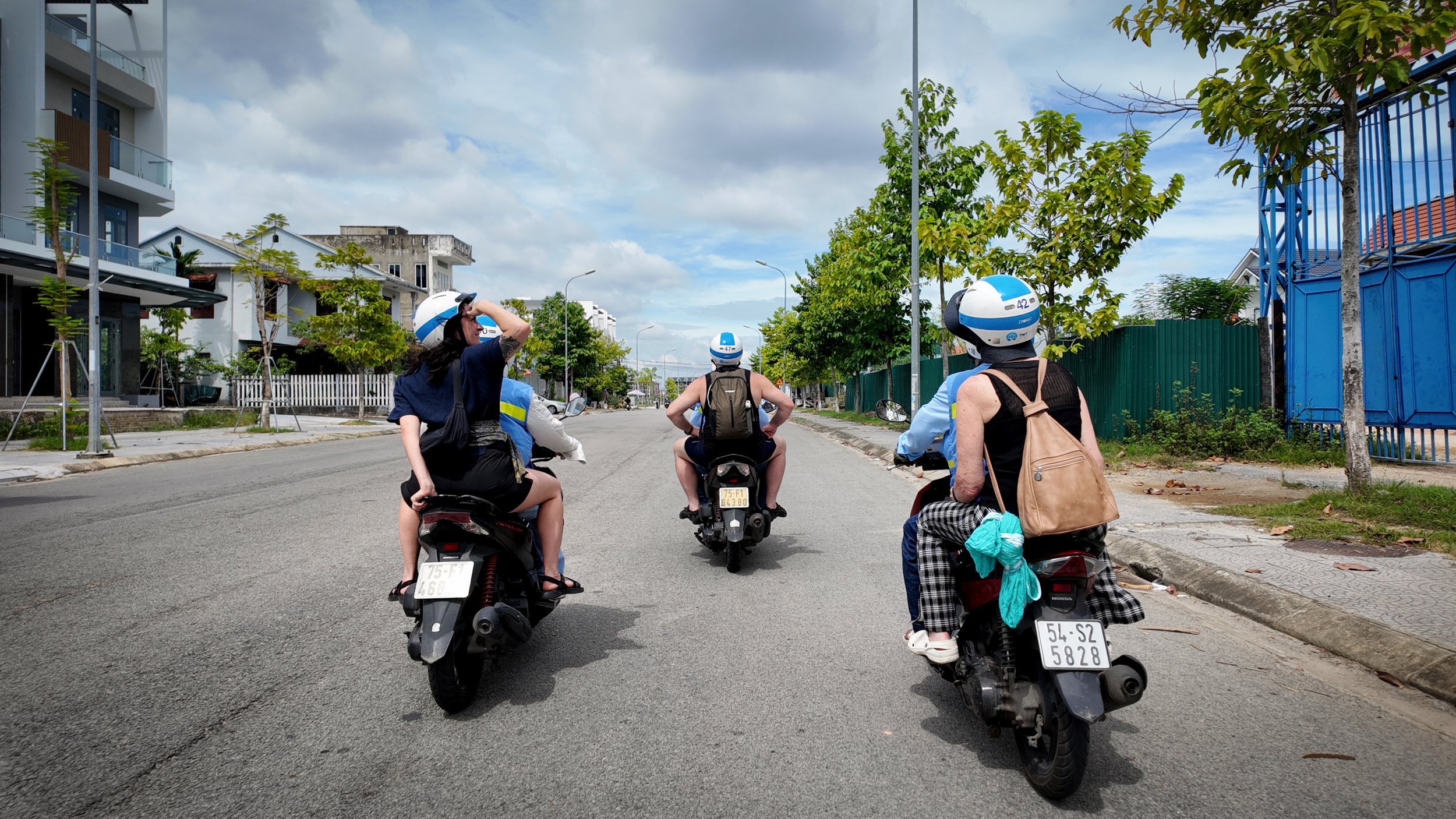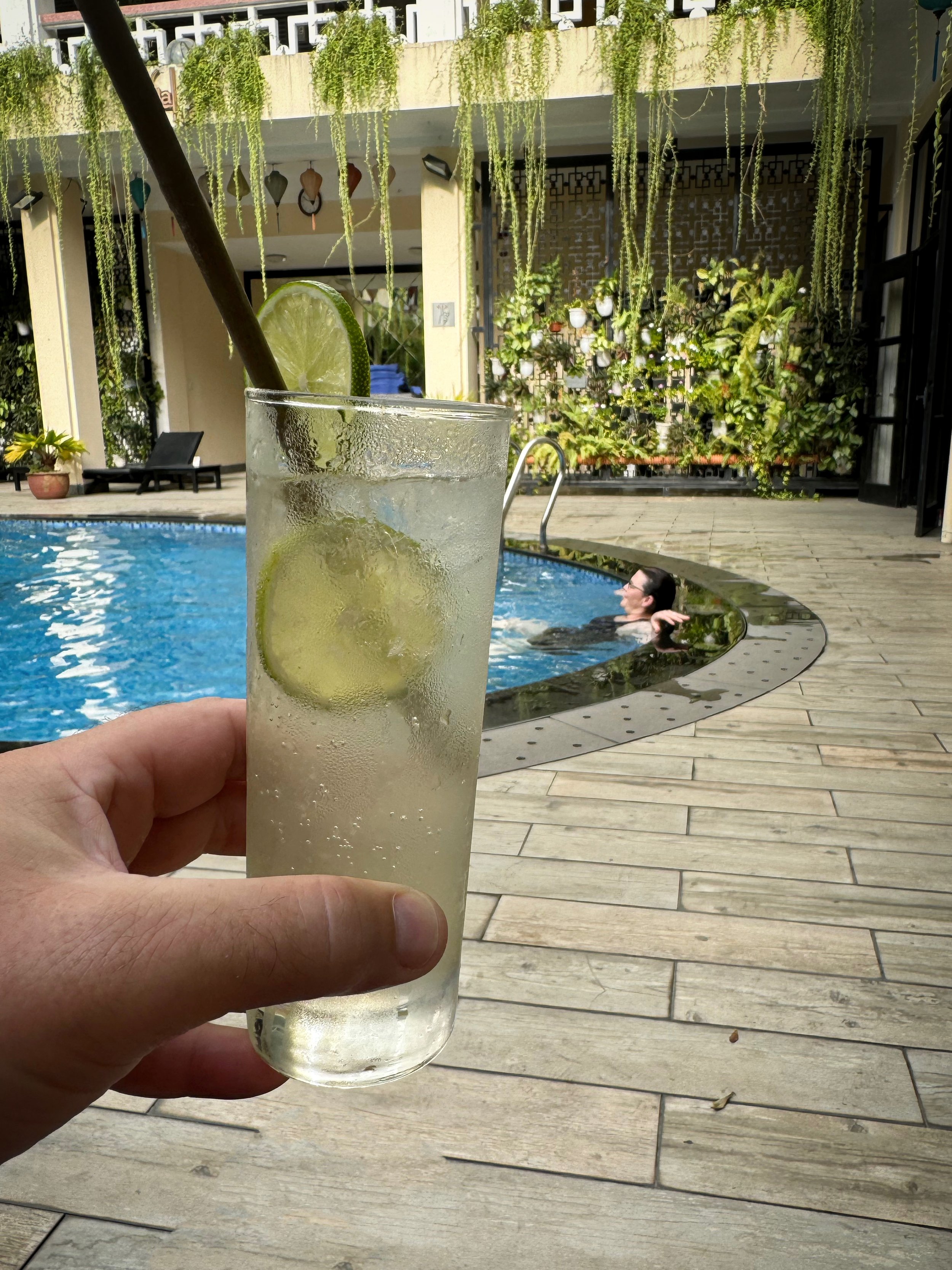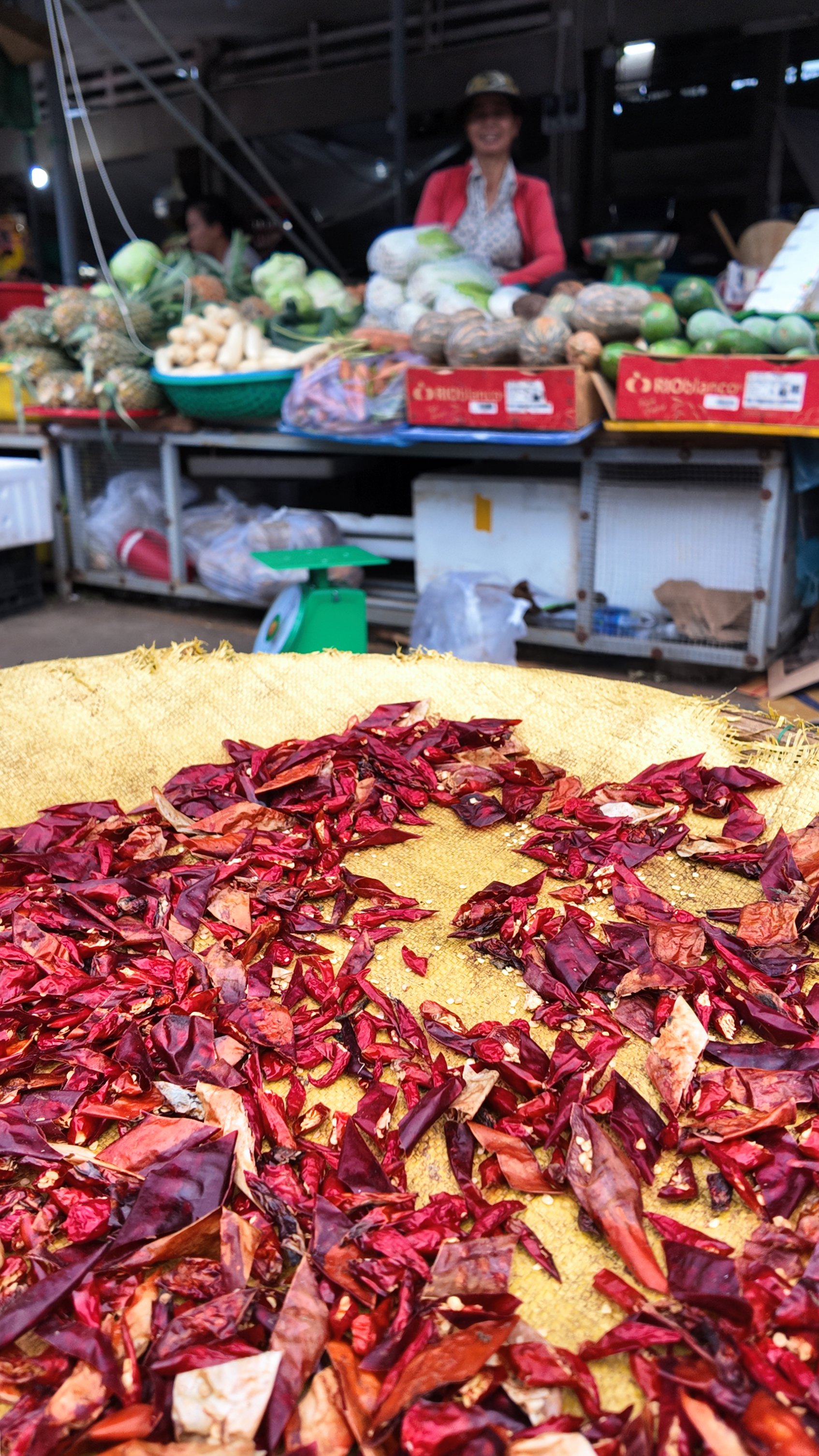9th Uprising - Hue
Our second day in Hue started with an early breakfast before an unplanned stroll around the immediate vicinity of the hotel. Here street vendors were setting up for the days trade within the shadow of governmental buildings such as the police departments provincial headquarters. Hue is a city chock full of stories with its refined cuisine widely regarded and its leafy streets lined with mossy pagodas, art déco mansions and eye popping markets. Through the whole scene flows the Perfume River setting a languid pace the rest of the city is happy to follow.
A tour highlight was scheduled this morning with a half day motorbike exploration of the city and its major attractions. Assembled in the hotel courtyard was a posse of 10 riders clad in blue hi-vis vests and face masks. Like a 1970’s suburban dinner party the keys were thrown into a helmet from which we drew our riders at random. From there it was just a matter of holding on for the first leg through city street, rural roads and small villages.
Our first stop was Thanh Toan Village to visit its famous tile roofed bridge. The village was founded by followers of Nguyen Hoang migrating to the area in the 16th century and the bridge built in 1776 by a 6th generational philanthropist named Mrs. Tran Thi Dao. Since her death in 1925 the bridge has become a place to worship her and the work she did for the local communities.
The adjoining markets are where local villagers purchase their agricultural produce including meat, vegetables, fish, and rice together with farming tools from other nearby villages. Through tourism the markets have expanded over time and we shopped a little before enjoying a coconut milk to escape the strengthening heat.
Back on the bikes we tracked west headed for the 17th century active Buddhist monastery of Thien Mu Pagoda. Situated on Ha Khe hill on the north bank of the Perfume River, it was build in 1601 following a prophecy by an old woman appearing on the hill telling local people that a Lord would come and build a Buddhist pagoda for the country’s prosperity. Strangely self fulfilling, Lord Nguyen Hoang therefore ordered the construction of the pagoda calling it “Heaven Fairy Lady” from where its name of today is derived.
Phuoc Duyen tower, Thien Mu pagoda, Hue, Vietnam
The most striking feature of the pagoda is Phuoc Duyen tower erected in 1884 which has become the unofficial symbol of Hue. This octagonal spire has seven storeys dedicated to Buddha and is the highest stupa in Vietnam. To the left of this is a pavilion sheltering an enormous bell cast in 1710 considered to be an outstanding achievement of 18th century bronze casting.
Thien Mu pagoda is like a tropical garden of ornamental plants and flowers while at the far end of the garden stretches a calm and romantic pine tree forest where a cool breeze somehow managed to come to life in heat of the morning. A leisurely stroll through this part of the grounds found lazy butterflies, exotic chickens and beautiful fernery everywhere.
During the summer of 1963 Thien Mu Pagoda became a hotbed of anti-government protest. Discontented with the rule of President Ngo Dinh Diem since finding power in 1955, South Vietnam’s Buddhist majority had long believed Diem showed strong favouritism towards Catholics with discrimination against Buddhists in the army, public service and distribution of government aid. Unrest exploded into mass protest when nine Buddhists died at the hand of Diem’s army in Hue. Buddhist protests were held across the country with Thien Mu Pagoda a major rallying point for the movement and often the location of hunger strikes, barricades and protests.
This culminated in Thich Quang Doc, a Vietnamese Mahayana Buddhist monk self-immolating at a busy Saigon intersection on 11 June 1963. His actions drew international attention for some time but sadly any government reforms promised were never implemented. Several more monks immolated themselves before a US backed coup toppled Diem in November 1963.
The vehicle once owned by Quang Doc and famously backdropping the award winning photograph taken in Saigon, is kept on display at the pagoda.
Through back streets and some dubious shortcuts, we pulled into a literal street of shops specialising in the production of incense sticks. Having had the tour to the Incense Village cancelled only a few days before, Fatpap was ecstatic and almost fell off the bike in his eagerness. The sticks are made by taking a base mixture and kneading that into a hard dough which is then spread thinly onto an angled table top with a “trowel” like tool. A bamboo stick thinly split dozens of times is laid upon the spread then rolled over it with the trowel tool to collect the paste evenly. Finished sticks are then bunched together and fanned symmetrically to sit and dry in the sun. The process looked simple but of course wasn’t, however the array of drying incense in varying colours and arrangement were not only eye catching but truly mesmerising.
Our second to last stop was at the lakeside royal tomb of Emperor Tu Duc nestled in a vast pine forest and built in 1864. Following a brick tiled walkway from the Vu Khiem Gate, we walked to the Khiem Cung Gate towering over a placid lake where the emperor would boat and hunt small game on a tiny island. At the lake Tu Duc grew many rare species of flowers, some still thriving to this day, and built pavilions where he indulged in refined pastimes like playing chess, enjoying tea, and reading books.
Tu Duc held the throne from 1847 to 1883 marking the end of Vietnamese independence after ceding to the French colonialists. Caught between the country's complex circumstances and his own tragic life without a descendant, to escape from his melancholy he designed and built this palatial sanctuary not only as a retreat but as his own mausoleum.
Although he had 104 wives and concubines he was unable to father a son, thus it fell to him to write his own epitaph on the deeds of his reign. The stele containing it is the largest of its type in Vietnam and was quarried over 500 kilometres away taking a total of four years. Despite the grandeur of the site and the amount of time Tu Duc spent there, he was buried in a secret location somewhere else in Hue. To keep that safe, the 200 labourers who buried the king were beheaded when they returned. Ironically, after all the trouble gone to ensuring his remembrance, to this day the real tomb of Tu Duc remains unknown.
Everyone was now peckish so we jumped in the saddles one more time for a short trip to a local nunnery for lunch. An odd place it would seem for a lunch but the only real difference were shoes needed to come off and no alcohol was allowed. You will imagine good reader that with the group harmonising the way they had been by the steady tuning fork of alcohol, everyone was up in arms. Devoted servants of Christ or not, there was no bloody way we were going to take off our shoes! The food was spectacular again comprising a selection of dishes both traditional and local and of course, not a morsel was left.
We arrived back at the hotel early afternoon safe and sound, and with the rest of the day free you can bet what we did. Poolside. Swim. Cocktails. Frivolity.
In the early evening the group opted for a cyclo tour through the old part of town. Originating from the French word “cyclo-pouse”, the mode of transport has remained a stalwart in a city renowned for its eco friendly, relaxed way of life. For the second time today the hotel courtyard was ringed by 12 of the contraptions manned by a dozen men in matching uniforms and red hats. It truly was the most entitled thing any one of us had ever done that in days to come would be referred to as the “imperial pram ride.” The only thing missing was an entourage of eunuchs oscillating the stifling heat with freshly hewn palm fronds.
After a short trundle we stopped at the local markets for a walk around the cluttered stalls of mostly food stuffs. Just about every ingredient imaginable provided a visual and olfactory smorgasbord with more touristy items filling the internal stands of the maze-like pavilion. The Hue Markets were much like every other in Southeast Asia but a fun and exciting experience nonetheless. We re-boarded our socially advantaged prams for a longer ride this time just as the sun was setting and the temperature dropped slightly. Pushing further into the rural parts of town and almost circumnavigating the Imperial Citadel discovered yesterday, in single file we rode returning waves to endless young children while weaving through motorbikes and cars the closer we got back to town.
Returning after 90 minutes of embarrassing public privilege, we proudly used our own legs to walk around the corner to a local restaurant for dinner. Not for the first time Chairman Bao organised tasting plates of a dozen Vietnamese dishes as we collectively dinned on refectory style tables with endless beers and glasses of wine. As always it was a fun night of great company and excellent food, with those normally without an off-switch kicking on afterwards. On the corner of a 5 way intersection we grabbed a second story balcony table and ordered an opening round. Not long after, Tom and Rachel joined us and things got a little rowdier by their presence. To make things worse Atharva instigated a frat-boy drinking game escalating the pace perhaps unnecessarily, and before we knew it things were soon out of hand. Rachel broke her mid-bus shackles becoming the life of the party as we had always suspected, demonstrating a canny trick where she would swig from any empty bottle passed her way ensuring it was in fact finished. We are pretty confident she had a yak later that night as a result.
The walk home was a short one with bed graciously accepted after a day full of firsts in and around Hue.
























































































































































